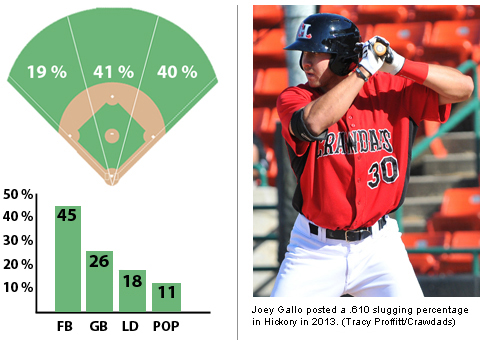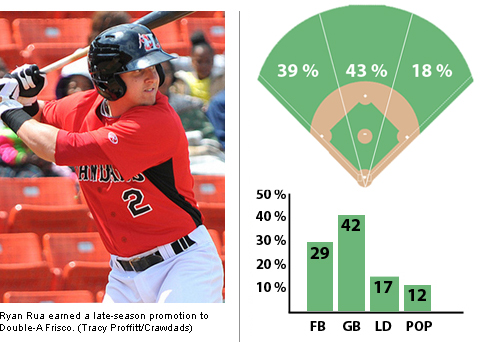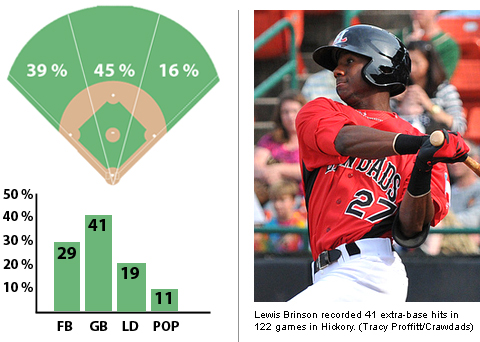Crawdads trio swung power bats in '13
Maybe it didn't matter what stadium Joey Gallo, Ryan Rua and Lewis Brinson played their home games at last season -- they were probably going to hit a lot of home runs (and strike out a bunch) wherever they called home.
But put those three -- and the rest of a powerful, free-swinging bunch of Hickory Crawdads -- together on one team, and L.P. Frans Stadium, already one of the most homer-friendly parks in full-season Minor League Baseball, suddenly seemed tiny.
Whenever you put together a team of strong, inexperienced free-swingers, there's always the risk of low contact rates and gaudy strikeout numbers. If you don't put the ball in play, it's irrelevant how big or small the park is.
And that's what happened in Hickory -- Gallo mashed 38 homers despite striking out 165 times, Rua hit 29 dingers and whiffed 91 times and Brinson went yard on 21 occasions but collected 191 punchouts. They were the main actors on a Crawdads team that had a record-setting season in power and whiffs. Hickory's 178 homers toppled Macon's previous South Atlantic League single-season record of 173, set in 1998. (Marcus Giles, who later played seven seasons in the Majors, clubbed 37 home runs for that Macon team.) The 1,403 strikeouts as a team were the most by any team in Minor League history.
That's a lot of power and -- just as importantly -- a lot of swing-and-misses.
While home run rates at the Major League level may never climb as high as they were in the late 1990s and early 2000s, strikeout numbers continue to increase.
In 2008, the strikeout rate of 17.5 percent set an all-time high. In each of the five seasons since then, this record has been broken. In 2013, batters struck out 19.9 percentage. Related to this inability to put bat on ball, the league-wide 7.9 percent walk rate was the lowest such mark in 46 years
"I'll never have a team like the team I had last year," said Hickory manager Corey Ragsdale. "Everyone talks about the home runs, but that wasn't something we talked about with our hitting coach. We didn't work on that, it's just something that happens when you have big kids who backspin the baseball.
"It's a little bit of a cop out to say it's just the ballpark. Maybe it plays into a little bit, but not as much as people like to think. The wind blows in, maybe because it sits down at the bottom of a big hill. But if you ever go to the Sally League, you'll see there are parks that are much more hitter friendly. But there are also parks that are much less hitter friendly and we still hit them out of there, too. I think it was just a crazy collection of talent, with Joey and Ryan and Lewis."
But those power numbers can't all be attributed to the park. Sure, the Crawdads tore the cover off the ball, but 45 percent of their homers came on the road.
The Crawdads hit 78 homers on their travels, more than Lakewood (49), Savannah (50), Hagerstown (56), Delmarva (57), Lexington (59), Greenville (60), Rome (60), Kannapolis (62) and Augusta (67) hit in total.
Gallo and Rua, with a combined 67 long balls, matched or eclipsed the totals of those nine clubs.
Though Rua and Brinson performed significantly better at home, Gallo's statistics were pretty consistent throughout the season. In fact, his power numbers increased on the road, somewhat corroborating his anecdotal remark that Hickory's park seems to actually play neutral, despite what some people suggest.
Home/Road Splits
| PLAYER | VENUE | GAMES | AVG | AB | R | H | HR | RBI | BB | SO | OBP | SLG |
|---|---|---|---|---|---|---|---|---|---|---|---|---|
| GALLO | Home | 54 | 0.249 | 201 | 43 | 50 | 16 | 39 | 28 | 87 | 0.348 | 0.567 |
| Road | 52 | 0.241 | 191 | 39 | 46 | 22 | 39 | 20 | 78 | 0.319 | 0.654 | |
| RUA | Home | 54 | 0.269 | 193 | 44 | 52 | 18 | 50 | 27 | 48 | 0.380 | 0.622 |
| Road | 50 | 0.230 | 174 | 26 | 40 | 11 | 32 | 22 | 43 | 0.328 | 0.489 | |
| BRINSON | Home | 60 | 0.267 | 217 | 39 | 58 | 12 | 31 | 27 | 87 | 0.354 | 0.484 |
| Road | 62 | 0.209 | 230 | 25 | 48 | 9 | 21 | 21 | 104 | 0.292 | 0.374 |
To put Hickory's 2013 power output another way, the team accounted for 16.3 percent of the homers in the 14-team league, more than 100 homers above the league average of 77. The next closest South Atlantic League team to the Crawdads was the Greensboro Grasshoppers with 108, and only one other club -- the Asheville Tourists -- reached triple digits.
No team in the Majors or the Minors went deep more often than once every 25.6 at-bats and only one of the 229 affiliated teams -- the Stockton Ports -- hit more homers than the Crawdads this year.
MiLB.com caught up with Hickory's power protagonists.
Joey Gallo
Gallo hammered a franchise-high 38 homers, the fourth-most in league history and two shy of Russ Branyan's all-time mark from 1996.
Still, with a .245 batting average and 165 strikeouts in 106 games, Gallo knows there's still work to be done until he considers himself more than just an all-of-nothing power hitter.

Gallo's Stats
| GAMES | AB | XBH | K% | BB% | K/BB | BABIP | ISO |
|---|---|---|---|---|---|---|---|
| 106 | 392 | 62 | 37 % | 11 % | 3.4 | 0.309 | 0.365 |
"It was kind of a struggle for the most part, and I was always trying to find my approach," said Gallo. "I didn't even have one for most of the year. Just trying to find my swing. I started to find it throughout the year. I was playing around with it throughout the year, just trying to see what would work.
"The thing with me is that I wanted to keep things simple. That's when I'm at my best. I was getting really big with my swing and trying to hit the ball too hard instead of putting the barrel on it. Usually I try to hit the ball to center field, but if I'm early on it I hit it to right field and if I'm late I hit it to left field. I don't try to force myself to go the other way."
With the big uppercut in his swing, Gallo feasted on pitches down in the zone and he was able to put loft any pitch, even those at his knees. Around two-thirds of his batted balls -- 129 of 229 -- were either fly balls or pop-ups, many more than Rua or Brinson, who produced a greater number of ground balls and line drives.
"I naturally am a [fly-ball] hitter," Gallo said. "When I hit the ball, it's usually in the air. I'm not looking to hit too many on the ground or on a line drive."
Considering Gallo's raw power and proclivity for fly balls, it maybe comes as little surprise that so many balls left the yard. But Gallo was reluctant to say L.P Frans Stadium played to his strengths.
"I would say our field is pretty much as neutral as any park. It wasn't too much of a hitters' park or a pitchers' park," he said. "A lot of time the wind was coming across from the right and it actually cut down some of my balls. Our right-handers loved it because the cross wind blew across to the left.
"Asheville was obviously a hitters' park, but in places like Charleston and Savannah you really had to get into one to hit it out. In Charleston the wind was always blowing in and in Savannah the dimensions there are just huge. But Ashville has a pretty short fence. It's high, but short, like 280 out to right field. If you hit the ball in the air, you have a chance of hitting it out."
Ragsdale on Gallo: "When I think of what he did, it's just unbelievable talent. The kid can do so many things. [His power] is all over the field and it's like nothing I've ever seen before. It's 'light tower power' for sure. When you have the grounds crew, other workers at the stadium, opponents standing in the dugout to watch his BP, you know it's pretty special. He's so big and strong and surprisingly nimble and flexible and he can hit it a long way when he squares it up."
Ryan Rua
The oldest of the trio, Rua entered 2013 having already played 126 games in pro ball over the past two seasons.
The infielder, who moved from third base to second base, had a higher batting average, fewer strikeouts and a better walk rate than either Gallo or Brinson. He led the team with 82 RBIs and he had the best on-base percentage (.356) among all full-time Crawdads.

Rua's Stats
| GAMES | AB | XBH | K% | BB% | K/BB | BABIP | ISO |
|---|---|---|---|---|---|---|---|
| 104 | 367 | 54 | 25 % | 13 % | 1.9 | 0.257 | 0.308 |
"When I was playing well, I wasn't even thinking about [my mechanics] at the plate," he said. "I was just in the flow. You get in those grooves sometimes. I have a high leg kick, but when I was in control of that, I was able to get my front foot down earlier to help me see the ball better.
"I've always been a gap-to-gap guy. We work a lot on getting down through the ball and getting extended to get that backspin, and in batting practice I try to use my hands more to get the ball to travel a little more."
Rua attributed the strikeout numbers -- 91, or around one in every four at-bats -- in part to playing in a full-season league for the first time, but he said he still plans on being aggressive to the fastball as he moves through the system.
Rua's 29 homers would have led the league in eight of the past 15 seasons, and had he not been promoted to Double-A Frisco, there was every chance that he would have joined Gallo in becoming just the third player in the South Atlantic League to hit 30 or more homers in the past five years.
"I've been working with the hitting coach for one or one-and-a-half years, so he knows my swing and I understand his teaching," he said. "He taught me to make sure I didn't get beat by the fastball because it may be the only pitch I get to drive, so I tried to get myself in good fastball-hitting counts.
"I hit around 20 home runs off of fastballs and around 10 off breaking balls and changeups. I would say I hit 20 home runs to left field and left-center, a couple to center field and five or six to right."
Ragsdale on Rua: "We knew he had power to all fields but the nagging thing was that he didn't have the chance to play every day. We wanted to give him that chance, that's why we moved him from third base to second so he could get everyday at-bats. He put up big numbers and he was our best bat in the middle of the lineup."He gets his hands through the zone and he gets the barrel to the baseball. He's short and straight to the ball and he has a long finish through the baseball that I like. He can hit it a really long way to left field or to right-center and he doesn't have to hit home runs in a 2-0 count. He hits 3-2 breaking balls for home runs and he can put good swings on balls in any count."
Lewis Brinson
A teenager until May, Brinson caught the eye of fans and opponents alike with his natural athleticism and a projectable combination of power and speed.
But for all the accolades regarding his tools -- he's also already developed a reputation for his outstanding defense in center field -- it was arguably his inexperience that drew the most attention.

Brinson's Stats
| GAMES | AB | XBH | K% | BB% | K/BB | BABIP | ISO |
|---|---|---|---|---|---|---|---|
| 122 | 447 | 41 | 38 % | 10 % | 4.0 | 0.362 | 0.190 |
The Florida native's 191 strikeouts led the league and finished just one whiff behind Modesto's Harold Riggins for the highest total in affiliated baseball in 2013. He ended the year 17 strikeouts shy of Darryl Landrum's league record of 208, a mark that has lasted almost three decades.
"I had a lot of swing and misses, obviously, so I have to cut down on those," Brinson said. "I had to get used to the pitchers and see what they were trying to do, so I was chasing a lot of balls outside the zone. I didn't have a plan up there, but I got a lot better and I'll continue to get better over time.
"I think breaking balls away really gave me a problem. I was leaving my front shoulder and giving up on that outside pitch because I didn't really recognize it. I kept swinging over it. In high school, I didn't face too many guys with good breaking stuff or secondary stuff to get me out. I knew that coming into my first full season."
Knowing the hole in his swing, Brinson made concerted efforts to fix the problem during his time in the instructional league.
"In instructs, I focused on my tee work, setting the ball up in the deep part of the zone," he said. "I have to wait for those pitches to come to me, so I was setting the ball up in a place where -- in a game -- I'd have to wait a little longer. I set it up at my knees or thighs and tried to hit it to right-center field. Every morning I would take around 100 good swings just to get that muscle memory down so I wouldn't pull off it and so that I could stay on it longer.
"It's a work in progress," he continued, "but we have been working on making more solid contact and getting on base instead of just swinging. I need to go up there with a plan and I have to cut those strikeouts down and become more of a contact hitter."
The team didn't discourage Brinson from trying to hit home runs, but the focus was very much on utilizing the power alleys to give himself the best chance of making things happen with his wheels. All of that is predicated on putting the ball in play, something he is intent on improving over the winter.
"I'm a line drive gap-to-gap kind of hitter so I can utilize my speed," he said. "I try to drive the ball to all fields.
"I do have a lot of power. The inside fastball is my strength -- I like that pitch, I feast on that pitch. That's a happy zone for me. But I'm looking to go all over the field. My power is to left field and left-center, but I try to stay to the middle of the field so I can use right field and right-center field."
Ragsdale on Brinson: "Lewis has unbelievably quick hands, sometimes you would say too quick. Maybe he doesn't trust them like he should, but he's very quick through the zone with his hands and he generates very good bat speed. He's just a freak athlete."He uses the left field a little more than the right, but he did hit balls out to right field, too. He hits balls in the gaps and runs like fire around the bases. I think as he gets bigger and fills out, he'll have easy pop just because of the fact that he has unbelievable leverage in his swing. But right now we're just working with him hitting balls on a line gap to gap."
Ashley Marshall is a contributor to MiLB.com. Follow him on Twitter @AshMarshallMLB.